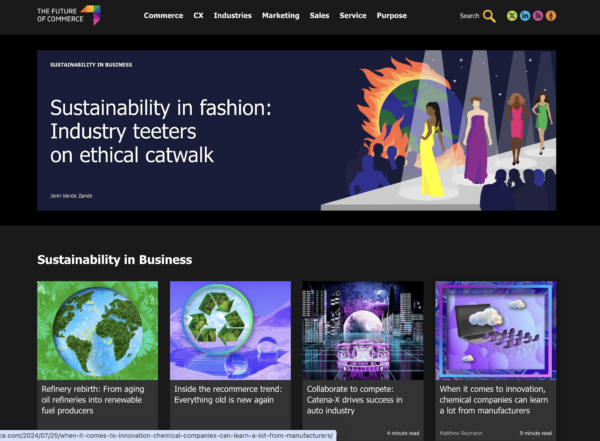The world is a noisy place right now.
There’s an election, nearly constant AI disruptions, and an unpredictable economy. But that’s not exactly (or only) what I mean.
In 2024, organizations put an even greater importance on digital content and content-driven experiences. And content and marketing teams now need to design content for value and reach on as many platforms as possible.
And you’re not the only one to get that memo. Technology is helping everyone (including your competitors) repurpose and scale that content to all those platforms.
Consider the implications for a moment.
I recently worked with a team at an interactive entertainment company that wanted to use AI to ramp up its short-form article production from 25 to more than 500 articles every week — or 30,000 posts a year.
That’s right: 30,000 posts per year.
So, it’s no wonder content and marketing teams feel like they’re shouting into a hurricane.
But here’s the thing. It has always been this way.
The too-much-content problem
There’s always been too much content in the world. Just about every successful internet company over the last quarter century has started with that as the core problem. Search, social media, and other digital platforms are all solving the problem of filtering the content firehose into something consumable.
Depending on your point of view, they’ve resulted either in elevating or destroying knowledge and information. Both are probably true.
Still, that doesn’t make figuring out your content marketing strategy any easier in the second half of 2024 — especially if you face expectations like my client’s.
Their boss rationalizes his desired content production frequency with this logic:
“We’ll never compete if we dive a mile deep into topics. Our competitors are publishing every day. They’re the ones getting the attention.”
In other words, more content equates to more chances to reach audiences, which equates to more value.
But, of course, it doesn’t.
More content doesn’t mean more value
Despite the advancements of AI, content creation still isn’t democratized (yet). It’s as challenging as ever to create high-quality, differentiated ideas.
Instead, AI (like the photocopier, word processor, camera, and printing press) democratized only the publishing and distribution of content.
With the aid of all this technology, people produce and distribute more content faster than ever. But the number of great ideas remains as scarce as ever.
That’s why all that content is both signal and noise. My noise drowns out someone else’s signal, and your signal quiets someone else’s noise.
It’s not surprising that content marketers rarely create truly unique content. Your thought leadership probably echoes broader trends that originated elsewhere. Your research likely uncovers evolving trends that others have already identified.
Content marketers probably won’t create the next great piece of literature or Pulitzer Prize-winning journalism (at least not as part of their day jobs).
And this is by design. As a marketer, you’re primarily in the business of popularity. You try to show up among the most sought-after signals without becoming noise. And you have to be “noisy” enough to be associated with the views popular among your desired audience.
Put simply: Most marketers can’t afford to be the lone voice for a particular topic or stance because they’re measured by how many people engage with the message.
So, unfortunately, your mission can’t be to avoid creating noise or to focus only on creating differentiating signals that no one searches for (no matter how fantastic they are).
Your mission is to make the most “right people” (i.e., those in your desired audience) care about your noise so they’ll take an interest in your signal. That’s the art of creating signals among noise.
So, how do you do that?
Think differently
How can you balance signal and noise? How can you differentiate your content while making enough noise to achieve popularity among the right people?
Well, as usual, entertainment media companies provide a helpful model.
Look to these media company-tested ideas:
Create ‘conscious’ content experiences
A “conscious” content experience involves knowingly and purposely evolving the narrative as the audience’s needs change without dropping the core story or values.
Media companies tell the same story repeatedly within changing pop-culture contexts or through the lens of different audiences. Look at all the ways they’ve told the story of Spiderman through various eras. The simple comic books of the 1960s and the multiverse movie adaptations featuring the teenage wallcrawler tell the same core story of an awkward teenager learning the great responsibility that comes with great power. Each retelling updates the story to resonate with current audiences.
You can take a similar approach with your blog, resource center, or other publication. You don’t have to lock yourself into a fixed editorial box focusing only on thought leadership research or how-to articles. Great publications can change their editorial focus as their audience needs or context changes.
Software company SAP does this today. In early 2020, the content team shifted the editorial strategy for the Future of Customer Engagement and Experience site to feature helpful information about the COVID-19 outbreak. This shift in focus helped them grow their traffic and, most importantly, build a loyal audience.
Once the focus on COVID-19 eased, the site (now called the Future of Commerce) shifted focus again. Its fluid editorial strategy now contains differentiating ideas on everything from how AI improves research management in higher education to how fashion brands maintain sustainability (shown in the image below).

Focus on different, not better
Media companies understand where they want to create differentiation with content and where they don’t. They also understand they don’t have to be the best in a category – they simply have to offer an alternative. Consider the hit television show The Office. In recreating the British show for U.S. audiences, the producers neither tried to copy nor improve upon the original hit show. They made something different.
Many content marketers focus on producing better research, more provocative versions of thought leadership, or bigger influencers to tell the same story as their competitors.
One of my clients, a consulting firm in the financial services space, tried something different instead.
Rather than focusing on developing more thought leadership or advice for its financial advisor audiences, the company went a different way. The content team created a community and online resource to help financial advisors discover the best new books to read. It wasn’t better than their competition. It was different.
Think quality for the long run
Some argue that if you produce enough content, some of it will rank high, go viral, or succeed in another way. Mathematically, this argument is probably correct.
But I find content and marketing teams that focus on creating differentiating pieces amid the requisite noise do better than those that focus solely on pumping out as much content as possible.
A recent Four Seasons case study in Ad Age (subscription required) offers a great example. When a TikTok video showing a 1-year-old child seemingly excited about the idea of staying at the Four Seasons in Orlando went viral, the company jumped on the opportunity by hosting the whole family for a vacation.
The content team documented the “Four Seasons baby” and family having various experiences, and the resulting content generated plenty of amused comments on social media.
@fourseasons Fully conscious and utterly fabulous at Four Seasons Orlando. 👑 #LoveFourSeasons #LuxuryTravel #FamilyTravel #FourSeasonsOrlando #FullyConsciousBaby ♬ MILLION DOLLAR BABY (VHS) – Tommy Richman
The brand put time (and care and feeding) into creating the Four Seasons baby but balanced the quality and quantity of all that content in a way that differentiated while being just noisy enough.
Be the right signal to the right audience
Using technology to pump out as much commodity content as possible may make mathematical sense. But that won’t solve the signal-versus-noise challenge.
Hiding the best signals in so much of your own noise makes it harder — not easier — to attract an audience that will care about your content. A glut of even good content distracts people from extraordinary content.
Create content because you have something to offer your desired audience. To those who care, you’re the signal. To those who don’t, you’re the noise.
It’s your story. Tell it well.
Updated from a March 2022 article.
HANDPICKED RELATED CONTENT:
Cover image by Joseph Kalinowski/Content Marketing Institute



